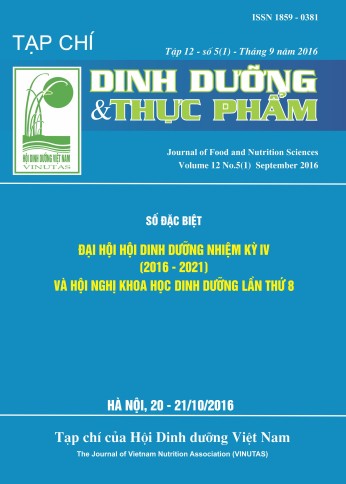THE SITUATION OF HYPERURICEMIA AND SOME RELATED FACTORS OF STAFFS IN HA NOI MEDICAL UNIVERSITY IN 2014
Main Article Content
Abstract
The study aimed to evaluate the prevalence of hyperuricemia and describe some related factors of staffs in Hanoi Medical University in 2014. Methods: A cross-sectional survey was conducted in 300 staffs in Hanoi Medical University. Blood analysis and quantitative questionnaire were used to evaluate the prevalence of hyperuricemia and describe some related factors. Results: The mean age of subjects was 39.2 ± 10.2. Males took 33.7% and females took 66.3% of the sample. The prevalence of hyperuricemia was 23.3% (45.5% in men and 12.2% in women) and it increased by age
groups. Related factors having statistical significance with hyperuricemia were being male, age (older than 40 years), obesity, belly fat, high waist-hip ratio, increased cholesterol level, increased triglyceride level, frequent consumption of red meat and beer (p<0.05). Conclusion: The anthropometric and biochemical indicators have considerable significance on early detection and forecasting for high risk communities with hyperuricemia.
Keywords
Hyperuricemia, related factors
Article Details
References
2. Lê Văn Đoàn (2008). Nghiên cứu nồng độ acid uric máu ở cán bộ quân đội tuổi trung niên tại Quân khu V, Luận án Bác sỹ chuyên khoa cấp II, Học viện Quân Y.
3. Bộ môn nội (2012). Rối loạn chuyển hóa Glucid, Bài giảng bệnh học nội khoa. Nhà xuất bản Y học, tr 327.
4. Bộ Y tế ( 2013). Các xét nghiệm chẩn đoán bệnh tim mạch, Hóa sinh lâm sàng. Nhà xuất bản Y học, tr171
5. Bộ Y tế (2003). Các giá trị sinh học người Việt Nam bình thường thập kỷ 90-thế kỷ 20. Nhà xuất bản Y học, Hà Nội.
6. De Vera M. Bhole V., M. M. Rahman (2010). Epidemiology of gout in women: Fifty-two-year followup of a prospective
cohort. Arthritis Rheum, 62(4), tr. 1069-1076.
7. Phan Văn Hợp (2011). Tình hình tăng acid uric máu và kiến thức, thực hành dinh dưỡng ở người cao tuổi tại hai xã huyện Vụ Bản Nam Định năm 2011. Luận văn thạc sỹ Y học, Trường Đại học Y Thái Bình.
8. Curhan G. C. Hak A. E., Grodstein F., et al. (2009). Menopause, postmenopausal hormone use and risk of incident gout. Ann Rheum Dis, 69(7), tr. 1305-1309.
9. Wang M. H Chiou W. K, Huang D. H, et al. (2010). The relationship between serum uric acid level and metabolic syndrome: differences by sex and age in Taiwanese. J Epidemiol, 20(3), tr. 219-224.
10. Trần Văn Lộc Doãn Thị Tường Vi, Quách Hữu Trung (2008). Tìm hiểu một số yếu tố liên quan tới tăng acid uric máu và bệnh gút ở người trưởng thành tại bệnh viện 19-8. Tạp chí Dinh dưỡng và Thực phẩm, 3(4), tr. 170-177.
11. Phạm Thị Thu Hương Nguyễn Thị Lâm, Nguyễn Trọng Hưng (2011). Đánh giá thực trạng khẩu phần, thói quen ăn uống của người tăng acid uric máu và bệnh nhân gout. Tạp chí Dinh dưỡng và Thực phẩm, 7(1), tr. 60-68


